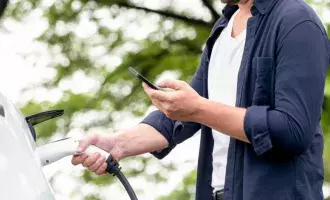As we’ve noted before(1), next-gen energy consumers are prioritising household and community technologies that support the UK’s drive to carbon net zero.
These include electric vehicles (EVs), combined heat and power (CHP) and microgeneration equipment like solar panels, small wind turbines and even hydropower systems. We’ve also pointed out that energy suppliers that fail to consider the customer experience perspective, especially around the service platforms that will enable consumers to engage with these technologies, do so at their peril.
Until recently, uptake of these technologies has been ad hoc, even gradual, but the Government’s Energy White Paper(2), places greater emphasis on net carbon zero and the trend will accelerate as we move towards that goal. As the Government incentivises consumers and businesses to adopt green technologies (despite having suspended its Green Homes grant scheme(3) , )we’ll become less reliant on big generation sites to create electricity or on the pumping of North Sea gas. A core part of the net zero strategy has always been for consumers to start generating their own energy for consumption and export – for demand and supply to be in the same place or more localised, resulting in an energy cycle rather than a chain with demand at one end and supply at the other.
Here we look at the development of some key products and services for next-gen prosumers in the new energy ecosystem.
Combined heat and power
Nearly two thirds of the potential power created by electricity generation units is lost as thermal energy(4), . CHP systems capture that thermal energy and use it to heat homes, factories, offices or schools. According to government advice, CHP technology offers the most significant single opportunity for users to reduce energy costs and improve environmental performance, typically saving around 20% of energy costs and reducing carbon emissions by 30%(5), .
This technology presents a substantial opportunity for suppliers to serve energy-savvy organisations and individuals with new products and services, but they will need to carefully rethink their revenue models and operations to meet these next-gen consumers’ needs. A key challenge will be to integrate equipment purchase, servicing and insurance, as well as ongoing power generation, into the business model. Another will be to provide customers with the tools to manage the total power and heating system and create an integrated customer experience that doesn’t require a plethora of new app downloads. A third will be to educate customers and upskill employees to ensure smooth installation and ongoing service.
Smart meters
Installing smart meters in people’s homes allows them to understand their energy use in real time and enables the industry to improve customer service. But smart devices are irrelevant if you can’t process the data that they provide and use it to guide your decision making.
To have value, smart meters need to be used correctly. Upskill your engineers so they can install smart meters and other technologies such as solar panels, and equip your customer service agents with the language they need to help the customer to use them. This encourages customers to use that information too, to track how they use, store and generate energy.
Over time, you can introduce new functionality into smart meters to expand the types of data they gather. Time of use data, for example, is invaluable for managing network stability. Energy use profiles aren’t static or predictable any more(6), . “TV pickup”, the phenomenon of a significant surge in energy use happening during broadcasts of tense episodes of soap operas or live football matches as viewers across the country rush to make cups of tea during the ad breaks(7), , no longer holds true. With remote working, on-demand entertainment and other innovations making our lives ever more flexible, time of use can’t be predicted as reliably as it used to be(8),.
The data collected by smart meters could have much broader applications than energy management. For instance, with the householder’s consent, energy usage data could be used as a non-intrusive way to support people who have a long-term health condition or are vulnerable in other ways. Irregularities in their energy usage patterns could trigger a text alert to relatives or carers that they may need to check they’re okay(9),.
Once more devices are connected, it may even be possible to spot whether someone has left the hob on overnight. There are already products on the market offering services like these but, by installing smart meters in more homes, the industry could contribute to a broader, nationwide approach to telehealth and telecare. This could enable people to live in their own homes for longer, reduce GP visits and shorten hospital stays.
Smart meters could also be used to identify families at risk of fuel poverty and to support them. To realise these possibilities, energy companies will have to work closely with other sectors to manage the data effectively, possibly taking on a new role as data service providers or partners.
Microgenerators
Individual consumers already have the opportunity to become energy producers, using microgenerators such as solar panels on their homes or joining community microgeneration schemes such as wind turbines. Community organisations installed 15.4 MW of new electricity generation capacity in 2019, bringing total UK community-owned capacity to 264.9 MW(10),
Soon these next-gen consumers will have a choice between exporting excess energy to the grid, selling it to a peer or storing it. This is great progress, but more choice is also confusing. There’s a role for suppliers to play here, selecting the best option for customers’ needs with the help of AI and machine learning. Most customers will want guidance on which option best serves their goal, whether that’s to make money, make things easier or reduce their environmental impact.
Existing energy suppliers will need to carve out their role in selling, supporting and servicing the new microgeneration and distribution infrastructure, and to understand how this will affect their current revenue models.
Electric vehicles
Electric vehicles (EVs) almost double a consumer’s electricity consumption in their home. With the drive to replace petrol and diesel cars, what effect would it have on the grid if every driver in the UK plugged their vehicle in at the same time? Real-time data on energy usage for charging and microgeneration needs to become part of the EV story, too — and that’s where energy suppliers come in.
Once again, an integrated customer experience, in which microgeneration, EV charging and other energy and heat uses are managed seamlessly, will be vital, as will data analytics to keep the system balanced and the grid stable. Customers are already becoming producers: the number of community organisations involved in low carbon transport projects increased by 62% in 2019, with 47 communities actively developing initiatives to accelerate the uptake of electric vehicles, charging infrastructure and low carbon community transport(11),.
As we evolve to a model in which both demand and supply occur locally, suppliers will need to review their business models and think about the following when creating their products and services for next-gen customers:
- Customer life cycle: Interactions will no longer follow a typical customer life cycle of join > bill > change > leave. Next-gen customers will buy physical products throughout this lifecycle that require installation, maintenance and insurance. They’ll want advice about using these products in conjunction with the typical electric and gas commodity products that they buy now
- Hedging and trading: Customers will want to understand more about how to trade the energy they produce. Some may want help to set up and then manage it themselves while others may want someone to look after it for them
- Advice: Customers will want to know how to reduce their carbon footprint — who will advise them on the best option? There are so many choices available and it can be very confusing. Suppliers will need to help customers to understand how things are evolving in the market and what they can expect
- Education of customer contact agents and engineers: Team members will need training to understand how the ecosystem fits together and to explain this to customers. Business will need to work alongside government education programmes and incentives.
Customer experience is key
Companies that provide CHP, solar panels, EVs and so on need to think beyond simply supplying the consumer with a product. Adopting their customers’ perspective is going to be key to their success. As we saw when discussing the next-gen consumer and their expectations(12), good customer experience means providing a service that encapsulates energy consumption, generation and management.
A provider that can cover everything via a one-stop, oven-ready platform will reap the benefits – the more products a customer has, the more ‘sticky’ they become, especially if the experience is seamless, and the less likely they are to leave. Apple is a classic example of the power of this approach.
The time to act is now. Although you can’t yet move into a new build pre-fitted with all the components of the net-zero lifestyle, legislation and policies due later this year will direct or incentivise architects, planners and builders to integrate them. And organisations need to be ready to service, insure and update them.
Look out for the next article in this series, in which we’ll be looking at the growth of insurance as a key part of the industry.
References:
[1] https://www.capita.com/our-thinking/consumer-2.0-next-generation
[2] https://www.gov.uk/government/publications/energy-white-paper-powering-our-net-zero-future
[3] https://www.bbc.co.uk/news/science-environment-56552484
[4] https://www.epa.gov/chp/what-chp
[5] https://www.gov.uk/guidance/combined-heat-and-power
[6] 4 ways lockdown life affected UK electricity use | National Grid Group
[7] ESO: Future Energy Scenarios for the next 30 years | National Grid Group
[9] https://www.capita.com/our-thinking/consumer-2.0-next-generation

Rupal Patel
Account Leader, Critical Infrastructure
Rupal is a proven leader with a track record of delivering in challenging circumstances without compromising quality or losing sight of the overall business strategy. She has played a fundamental role in transforming the utilities sector and implementing digital and innovation practices and is a recognised source of expertise in the utilities and smart energy industry with over 15 years of experience.







